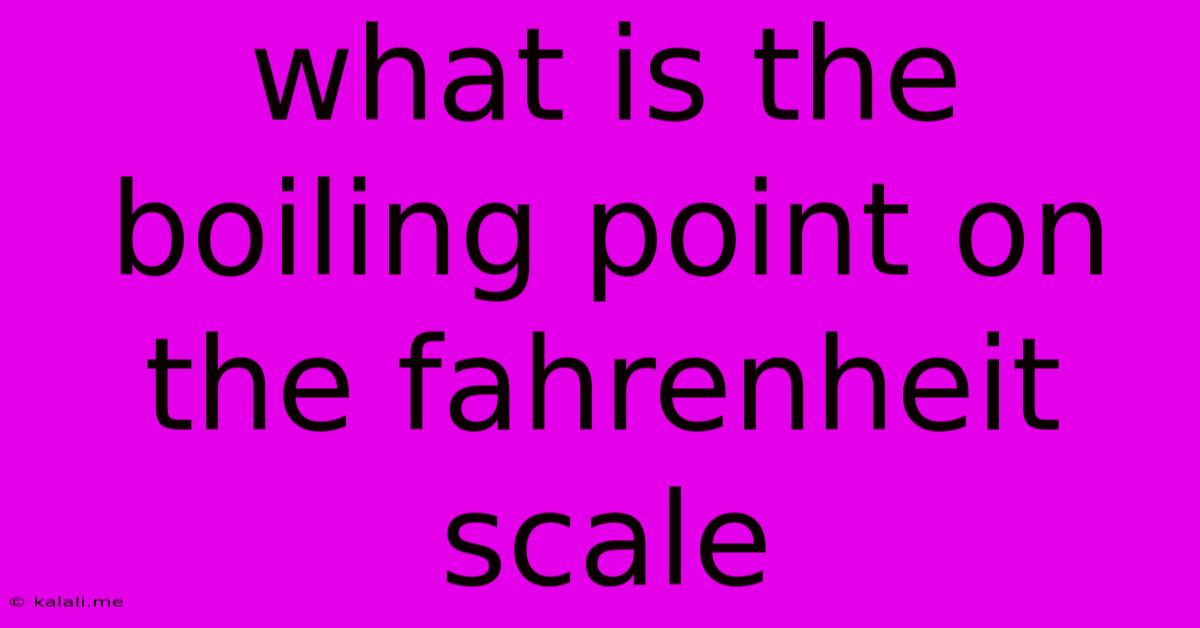What Is The Boiling Point On The Fahrenheit Scale
Kalali
Jun 13, 2025 · 3 min read

Table of Contents
What is the Boiling Point on the Fahrenheit Scale? Understanding Water's Boiling Point and its Implications
The boiling point of water, a fundamental concept in science and everyday life, is the temperature at which water transitions from a liquid to a gas (steam). This temperature varies depending on the pressure exerted on the water, but at standard atmospheric pressure (sea level), the boiling point of water on the Fahrenheit scale is 212°F. This article will delve deeper into this crucial temperature, explaining its significance and exploring related concepts.
Understanding the Fahrenheit scale itself is important. Unlike the Celsius scale, which sets the freezing point of water at 0° and boiling point at 100°, Fahrenheit uses different reference points. While the exact origins are debated, the scale was developed by Daniel Gabriel Fahrenheit in the early 18th century.
Why is 212°F the Boiling Point of Water?
The value of 212°F isn't arbitrary; it's a consequence of how the Fahrenheit scale is defined. Fahrenheit calibrated his scale using a brine solution (water and salt) and the human body temperature. The precise process is complex, but the result is a scale where the boiling point of water under standard atmospheric pressure falls at 212 degrees.
The Importance of Standard Atmospheric Pressure
It's crucial to remember that the boiling point of water is heavily influenced by atmospheric pressure. At higher altitudes, where the atmospheric pressure is lower, water boils at a lower temperature. Conversely, at higher pressures, water boils at a higher temperature. This is why pressure cookers work – they increase the pressure inside, allowing water to boil at temperatures above 212°F, leading to faster cooking times.
Boiling Point vs. Evaporation: Key Differences
While both boiling and evaporation involve a liquid turning into a gas, there are key distinctions. Boiling is a phase transition that occurs throughout the entire volume of the liquid at a specific temperature (212°F at standard pressure). Evaporation, on the other hand, occurs only at the surface of the liquid and can happen at temperatures below the boiling point. Evaporation is affected by factors like temperature, humidity, and surface area.
Applications of the Boiling Point of Water
The boiling point of water has numerous applications across various fields:
- Cooking: Understanding the boiling point is crucial for cooking various foods, from boiling pasta to steaming vegetables.
- Sterilization: Boiling water is a common method for sterilizing equipment and killing microorganisms due to the high temperature.
- Industrial Processes: Many industrial processes utilize boiling water for cleaning, heating, and various other applications.
- Scientific Experiments: The boiling point of water serves as a benchmark in various scientific experiments and measurements.
Conclusion: 212°F and Beyond
The boiling point of water at 212°F on the Fahrenheit scale is a fundamental constant in science and everyday life. While this value holds true under standard atmospheric pressure, understanding the impact of pressure variations is essential for a complete grasp of this important concept. From cooking to industrial processes and scientific research, the knowledge of water's boiling point remains crucial across many fields. Further exploration into related concepts, such as vapor pressure and phase diagrams, will deepen your understanding of this fascinating aspect of physics and chemistry.
Latest Posts
Latest Posts
-
Example Of Open Loop Control System
Jun 14, 2025
-
Which Of The Following Is A Weak Electrolyte
Jun 14, 2025
-
Which Of The Following Statements Are True Regarding Electric Generators
Jun 14, 2025
-
Which Era Is Referred To As The Age Of Mammals
Jun 14, 2025
-
All Of The Following Are Classified As Long Bones Except
Jun 14, 2025
Related Post
Thank you for visiting our website which covers about What Is The Boiling Point On The Fahrenheit Scale . We hope the information provided has been useful to you. Feel free to contact us if you have any questions or need further assistance. See you next time and don't miss to bookmark.